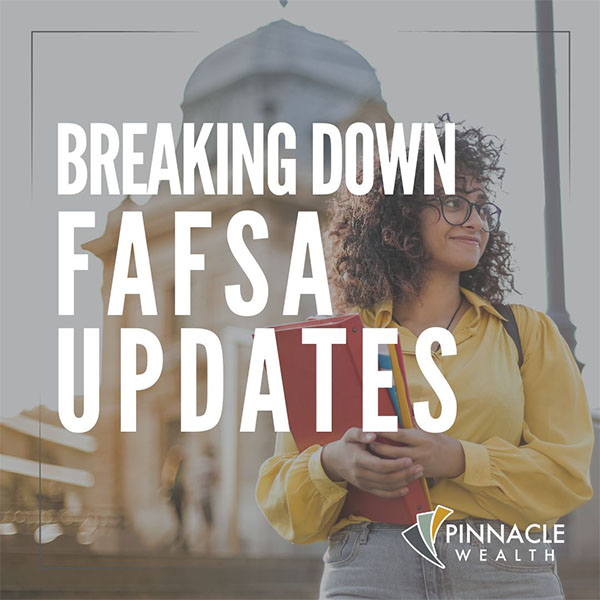by Ethan Brouwer, NSSA®, Associate Wealth Advisor
If you went to college, have had a child go through college, or have one currently enrolled, you likely know what the Free Application for Federal Student Aid (FAFSA) is. It’s also likely you aren’t too fond of it. You may have felt like the process was clunky, an invasion of privacy, and perhaps not even worth the time and stress of completing it.
For those of you who will still have to navigate this process: the good news is FAFSA just received an update in an effort to make it easier and more user-friendly.
But what’s the point of submitting the FAFSA anyway?
First, it determines if you are eligible for need-based aid. Need-based aid is free money through the form of grants that is given out based on your family’s determined financial need. You may not think your student will be eligible, but it is worth submitting just in case.
Second, some schools require you to file FAFSA to be considered for Merit aid. Merit aid is money awarded through scholarships – whether academic, athletic, or anywhere in between. Not all schools require this but there are some that do so it’s good to check with a school’s business office.
Finally, by filling out FAFSA, a student becomes eligible for Federal Direct Student Loans. Having to take on loans isn’t anything to celebrate but these are typically the best loans available for any student to get in their own name and without the need for a parent or guardian’s co-signing.
There are a few other changes that have occurred but here’s an overview of the main FAFSA updates:
One of the biggest changes in the new update is that FAFSA now allows the student and their family to consent to allow the Department of Education to access IRS data. This will make some of the FAFSA process easier. The old process required manual entry of all of a family’s income data – which for many families meant digging through old tax returns, trying to locate the numbers needed, and then manually inputting them. This new addition will make it easier to have accurate data and save the families time in having to locate that information.
Something to highlight: each family will need to consent to this. If families choose not to consent, they won’t be eligible for federal financial aid.
This change also helps to reduce the number of questions required by each family. Before the update, most families were required to answer between 50 to 108 questions. Now some only have to complete 18.
Another change is the calculation on how to qualify for Pell Grants, a.k.a. need-based aid. This will help lower income families become eligible to receive more financial aid. It is estimated that this change will help more than 600,000 additional students qualify for a Pell Grant.
Many families save for their children’s education through a 529 plan. However, in the past all of those assets, regardless of if the 529 was in the benefit of another child, counted in the calculation to determine need based aid. For example, if a family had two children and a 529 plan for each child, the total amount of both 529’s was counted against the children when calculating how much financial need- based aid they were eligible for. With this change, only the 529 for the child applying will be counted.
One negative change that has come from the updated FAFSA process is there’s no longer a discount to families who have multiple children in college at the same time.
Who do these changes primarily impact?
- Two household families – divorced/separated parents
- Families with multiple students in college
- Families who already had one child in college starting in 2023-2024 school year or earlier
- Parents who are business owners
- Low-income families
- Only student going to college 529 balance included
- Parents who make significant 401k/403b contributions
The reason these families are most affected by the updates is somewhat complex. We’re happy to talk through how these changes might impact your family and student’s financial situation.
The main goal of this change was to make it easier to qualify for some need-based merit to help counter the rising costs of a college education and to make completing the FAFSA forms easier and less daunting.
The process can still be difficult depending on your situation but our Pinnacle Wealth team is here to help! Whether you have questions as you’re filling out FAFSA for the first time or you’re trying to plan for a way to fund college for a child, we would be happy to guide you through the process.
Ethan Brouwer is a non-registered associate of Cetera Advisor Networks LLC.
Investors should consider the investment objectives, risks, charges and expenses associated with municipal fund securities before investing. This information is found in the issuer’s official statement and should be read carefully before investing. Investors should also consider whether the investor’s or beneficiary’s home state offers any state tax or other benefits available only from that state’s 529 Plan. Any state-based benefit should be one of many appropriately weighted factors in making an investment decision. The investor should consult their financial or tax advisor before investing in any state’s 529 Plan.
SOURCES:
Kolkka, Candice. “The FAFSA Is Here! Practical Insights and Guidance to Help Your Clients 1.11.24 – College Aid Pro.” College Aid Pro, 12 Jan. 2024, collegeaidpro.com/the-fafsa-is-here-practical- insights-and-guidance-to-help-your-clients-1-11-24/
Lonas, Lexi. “New FAFSA Forms Aim to Make College Applications Easier. Here’s What to Know.” Keloland, 29 Dec. 2023, www.keloland.com/news/national-world-news/ Accessed 12 Feb. 2024.


